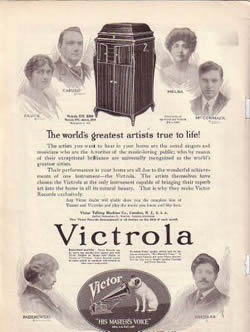While speeches, sermons, and other voice recordings enjoyed some success, popular music quickly became the largest selling category of phonograph records in the period from about 1890 to 1915. After a few years as novelty items in “phonograph parlors” (arcades with numerous coin-operated phonographs where customers could privately listen to a variety of recordings), low priced home machines began to appear. The top-selling cylinders of the period around 1900 were probably (based on their predominance in catalogs) military bands. Many of these military band recordings were actually dance music, described in catalogs according to the way people were expected to dance to it- waltzes, polkas, cakewalks, and so on. Yet the most famous leader of such a band, John Philip Sousa, had doubts about the phonograph and publicly denounced recordings as inferior to live music. Thus began a decades-long campaign against recorded music, sponsored by a succession of music critics, social theorists, and musicians.
As one of those social theorists has argued, the real significance of the early phonograph was that it transformed the way people listened to music. Where once music was a unique, live performance, experienced in a public place with a group, now it was heard privately in the home and it was possible to hear the same “performance” over and over. According to this argument, the listening experience was cheapened.
